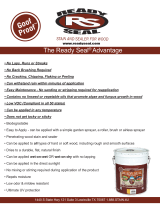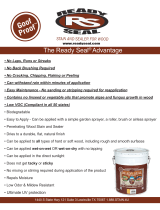Page is loading ...

MULTI-STRIP ADVANCED
PROFESSIONAL PAINT REMOVER-NMPFREE
TECHNICAL DATA SHEET
I. Description: Multi-Strip
Advanced is a unique,
environmentally safe paint remover designed to
remove up to 15 layers of paint in one application. The
new and improved version better penetrates multiple
layers and easily removes difficult coatings. Another
new feature is that a light application can quickly
remove a few layers of paint when time of removal is
important. It is biodegradable, non-flammable, non-
combustible and contains no methylene chloride, NMP
or caustic. Multi-Strip
Advanced is odor-free and can
be easily cleaned up with water. As a paste it clings
easily to vertical surfaces and completely fills detailed
areas. For application, it can be brushed, rolled or
sprayed on to the surface with a paint sprayer. In
addition, it creates less waste for easy disposal. It
requires no neutralization (neutral pH).
II. Types of Paint Removed: Multi-Strip
Advanced can
remove most varieties of paints & varnishes which are
oil or water-based including, latex, alkyds, stains,
enamels, lacquers and clear paints. Unlike other paint
removers, Multi-Strip
Advanced can remove more
difficult coatings such as two part epoxy, and
urethanes. Multi-Strip Advanced is also effective on
mastic, adhesives, and glues
III. Surfaces: Multi-Strip
Advanced can be applied on
a multitude of interior and exterior surfaces including
wood, brick, plaster, metal, marble, masonry, stone,
concrete, and fiberglass, etc. Multi-Strip
Advanced will
not damage plaster or wood (it will not discolor the
wood or raise the grain like other paint removers) or
affect any substrate it is applied to. It is not to be used
on sheetrock, plastic, rubber or linoleum surfaces.
IV. Instructions:
A. Preparation - Mask any areas not being stripped
with plastic and masking tape.
B. Application -
1. Test Patch - Since it is often hard to know the type
or the amount of paint on a surface, small test areas
should be stripped to determine the proper application
and dwell time needed for paint removal to occur.
1. For stripping 3 to 4 layers of paint
quickly - Apply Multi-Strip Advanced to the surface at
a total of approximately 1/64" thick (10 to 15 mils) with
a brush, roller, trowel, putty knife or sprayer. Can be
sprayed effectively using an airless sprayer Drill mix
before spraying - Remove filters from sprayer & spray
gun - Submerge pump directly into remover, Do not
use suction hose - Use NEW 1/4" or 3/8" airless hose.
Use at least a 1 GPM piston sprayer, .019-.021
reversible spray tip; a wet mil gauge should be used to
measure thickness. Let the product dwell from 15
minutes to 4 hours. Follow Removal Techniques at
Subdiv. C. Coverage for both, when used like this will
vary between 100 and 150 sq. ft. per gallon.
2. For removal of multiple layers or
stubborn coatings – Two test patches are suggested.
(I) First Test Patch - Apply the
stripper approximately 1/32" thick (30 mils) to the
surface. The patch then should be checked for dwell
time as follows (only a portion at any one time): Check
the patch first at 2 - 4 hours, then periodically
thereafter. As a rule of thumb, the greater the layers of
paint, the longer the product should be left on. The
stripper will usually remove 8 - 12 layers of paint in 24
hours. More layers of paint (20+) may take longer (2 -
3+ days). Due to the nature of certain paints such as
two part epoxy and urethanes, Multi-Strip Advanced
may need more time to be effective. Average dwell
time for these coatings may be 48 to 72 hours.
(II) Second Test Patch - In some
areas, some surface coatings (usually latex) soften
easily, causing puffing away from the surface. In these
cases, the stripper works differently so the patch
should be done as follows:
a). Apply a light coat of paint
stripper (approximately 5 - 10 mils) to the surface.
Wait 2 - 6 hours. If the surface starts to pull away, the
top layers have lifted from the surface and can be
easily removed with a scraper or knocked off the
surface with a broom or other device. The paint
remover has penetrated through these layers and
begins to soften the remaining layers.

b). While the undercoats are still
soft, apply another coat of stripper at approx. 1/32"
thick (20-25 mils) to the surface. The patch then
should be checked for dwell time as follows (only a
portion at any one time): Check the patch first at 2 - 4
hours, then periodically thereafter. As a rule of thumb,
the greater the layers of paint, the longer the product
should be left on. The stripper will usually remove 8 -
12 layers of paint in 24 hours. More layers of paint
(20+) or chemically resistant coatings may take longer
(2 - 3+ days).
c). This procedure usually applies
to stripping ceilings as well.
Coverage for both when used in this manner (I) and (ii)
varies between 50 and 75+ sq. ft. per gal.
3. Multi-Strip Advanced will easily cling to
vertical surfaces. Use your tool to fill detailed, intricate
or grooved surfaces. For best results apply at
temperatures between 60
0
F and 80
0
F. Product
activity is reduced below a temperature of 60
0
F and
may require additional dwell time before all layers of
paint are removed. If product freezes let thaw and stir
vigorously until product is consistent. No Neutralization
required. Clean-up with water.
C. Suggested Removal Techniques -
1. Plaster Surfaces -
(I) Flat Plaster Surfaces - Easiest
removal is achieved using a 4" or wider razor blade
scraper (commonly known as a wallpaper stripper) to
lift the remover/paint off the surface.
(II) Decorative Plaster (or Wood) -
Use a Back To Nature Stainless Steel Scraper with
5 function detail blade to lift the paint off the surface.
Use a stiff bristle brush with Ready-Strip Paint
Overspray or light amounts of water to remove any
residue.
2. Wood Surfaces -
(I) Flat Wood Surfaces - Easiest
removal is achieved using a Back To Nature
stainless steel scraper to strip remover/paint from the
surface. Use a stiff bristle brush with Ready-Strip Paint
Overspray or light amounts of water to remove any
residue.
(II) Decorative Wood - (see Decorative
Plaster)
3. Masonry, Concrete Surfaces - Remove
bulk of remover/paint with a stiff putty knife or wire
brush. Use a wire brush with Ready-Strip Paint
Overspray or light amounts of water to remove any
residue remaining. Residue can also be removed with
a high pressure washer where permitted.
4. Metal Surfaces - Agitate or rough up
remover/paint on the surface with a wire brush without
attempting removal. This helps to lift bottom layers
from the surface. Use a 4" or wider razor blade
scraper (wallpaper stripper) or stiff putty knife (pipe
railings or irregular surfaces should use the putty knife)
to lift remover/paint off the surface. Use a wire brush
with Ready-Strip Paint Overspray or light amounts of
water to remove any residue.
5. Note: Misting the applied area with Ready-
Strip Paint Overspray or water prior to removal makes
lifting of the paint or varnish easier. Misting with
Ready-Strip Paint Overspray or water also reactivates
the product if it feels dry to the touch. Any residue left
on a surface should be removed within a short period
of time so that paint residue will not dry up and re-
adhere. In some cases, it may look like the last layer
of paint is still on the surface. This is not a dried layer,
but paint which has been emulsified so it can be
removed.
V. Safety Instructions: Safety goggles are
recommended for eye protection. Wear protective
gloves such as butyl rubber, neoprene. Maintain
adequate ventilation especially in confined areas. If
spraying or misting is expected use NIOSH approved
chemical cartridge (organic vapor) respiratory
equipment (full face respirator recommended). In case
of inhalation - remove victim to fresh air and provide
oxygen if breathing is difficult. In case of eye contact -
flush exposed areas with large quantities of water. In
case of skin contact - wash skin with soap and water.
Use emollient skin creams. In case of ingestion - do
not induce vomiting. Call physician immediately.
VI. Advantages - Safest way of removing multiple
layers. Multi-Strip
Advanced requires no paper
covering thereby saving valuable labor time. Multi-Strip
Advanced has twice the coverage of competitors safe
strippers. It results in significantly less waste (1/2 +)
than caustic strippers reducing disposal costs. It stays
wet for extended periods of time. Multi-Strip
Advanced
can be applied by airless sprayer.
SUNNYSIDE CORPORATION
225 Carpenter Ave, Wheeling, IL 60090-6095 PH: 847-541-5700 FAX: 847-541-9043
/







